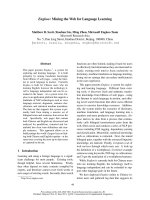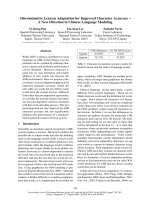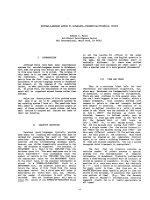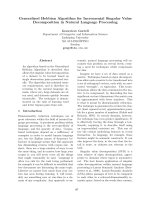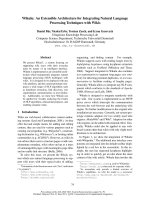Báo cáo khoa học: "NATURAL LANGUAGE INPUT FOR SCENE GENERATION " doc
Bạn đang xem bản rút gọn của tài liệu. Xem và tải ngay bản đầy đủ của tài liệu tại đây (593.75 KB, 8 trang )
NATURAL LANGUAGE INPUT FOR SCENE GENERATION M
Giovanni Adorni, Mauro Di Manzo
Istituto di Elettrotecnica, University of Genoa
Viale F.Causa 13, 16145 Genoa, Italy
Giacomo Ferrari
Istituto di Linguistica Computazionale, CNR
Via della Faggiola, 56100 Pisa, Italy
ABSTRACT
In this paper a system which understands
and conceptualizes scenes descriptions in natural
language is presented. Specifically, the following
components of the system are described: the syntac-
tic analyzer, based on a Procedural Systemic Gram-
mar, the semantic analyzer relying on the Conceptu-
al Dependency Theory, and the dictionary.
I INTRODUCTION
In this paper a system is presented, which under
stands
and conceptualizes scenes descriptions in
natural language (Italian) and produces simple stat
ic
images of the scenes. It is part of a larger
project that aims at understanding the description
of static scenes, reasoning (in case of incom-
pleteness or inconsistency) and dialoguing about
them, and finally generating and displaying them.
The Input Analyzer (IA) of the system is the
most stable end experimented component and it is
the topic of this paper. It consists of a Syntactic
Analyzer, a Cognitive Data Base (CDB) and a Seman-
tic Interpreter.
II SYNTACTIC ANALYZER
The syntactic analysis is performed by means of
a Procedural Systemic Grammar (PSG) (McCord,77).
The main characteristics of the PSG parser is that
the operation flow is highly structured, since
different levels of the analysis are associated to
the syntactic units of the sentence. Five processes
can be activated (CLAUSE, COMPL.GR, NOUN.GR, ADJ.GR
and VERB.GR) devoted to recognize respectively:
(i) the sentences, (ii) the propositional phrases,
comparatives, quantification and noun phrases,
(iii) the components of the noun phrases, (iv) the
adjectives and their modifiers, (v) the verb and
its modifiers.
Fig.l shows how these processes can interact in our
parser: double arrows indicate message passing and
Work
supported
by M.P.I. under grant 27430/81
single
I CLAUSE
[
,.1
h ! v o.
arrows indicate reading from input. Each
I N°UN'G"~I-'-
I
i ADJ.GR I-
I-
®
Fig.l - Levels of Syntactic Analysis
level is activated by the superior one, as shown in
Fig.l, and returns to its caller the results of
its computation as a message. A feature network
is associated to each process, which is activated
together with its corresponding processes.
In a PASCAL-like language the feature network can
be defined as follows:
type FEATURE (.LIST OF FEATURES.) ;
LINK=^NODE;
NODE=record
NAME:FEATURE;
VALUE:boolean;
FATHER,NEXT_BROTHER:LINK;
FIRST_SON,ALTERNAT:LINK;
end;
FEATURE NETWORK:array(FEATURE) of LINK;
Each
NODE represents s feature identified by its
NAME; the ALTERNATE pointer allows the connection
in a Circular list of mutually exclusive features
as in SHRLDU (Winograd,72). Each process gives as
output a fragment of the FEATURE NETWORK manipu-
lated to describe the input; this is performed by
means of a set of functions which test the presence
175
of a feature in the FEATURE_NETWORK, add and erase
features, as described in McCord ('77). The process
is divided into a set of sequential routines,called
SLOTs, analyzing the functional components of a
Syntactic Unit. In the function:
function FILLER(ARGI:PROCESS,
ARG2:SETOF_FEATURES):boolean;
ARGI activates the appropriate process to fill the
caller slot; the second argument of the function
selects the set of features to which the called
process must be inizialized.
This last features-passing mechanism is absent in
the original PSG; from our experience, we found
it usefull in all the cases in which a choice in
a syntactic level is determined by the syperior
level or by a more larger context.
Thus, for instance, the set of features character-
izing a prepositional phrase is determined at the
corresponding syntactic level by the preposition
and the features of the nominal phrase; but further
and not less important selection criteria can be
imposed by the verb which is found in the upper
level. The output of a simple analysis is shown
in Fig.2; it gives an idea of the syntactic repre-
sentation.
INPUT: IL M~O GATTO STA MANGIANDO {my
ca~
is eating)
RESULT OF THE ANALYSIS:
TIPO DICHIARAT.TVA ATTIVA (dec lara~ive active}
IL MIO GATTO SOGGETTO {suOJe¢~}
STA MANG IANDO VERB . GR
FEATURE NETWORK :
CLAUSE- ! -PROPOSIZIONE- ! -PRINC- ! -DICHIARATIVA
I -VERB. GR ! -PE"S ! -TERZA
! I
-NUM !
-SINGOLARE
! ! -MOUO ! -ESPLICITO- ! - INDICATIVO
I !
-TEMPO- ! -PRESENTE
I !
-ACT
f
-TRANSITIVA
! -FORMA- ! -STARE
!
f
-GENERICO
! -COMPL. UR ! -PERS ! -TERZA
! -GEN ! -MASCHILE
-gUM ~-SZNGOLARZ
-NOUN.C~-~ ONE
f
-TIPO-I-COMUNE
PSRS
FIG.2
- Result of a Sentence Analysis
The choice of PSG is mainly motivated by the possi-
bility of parallel computation. A control structure
allowing the parallel computation is:
cobegin coend;
It is a single input-output structure, very usefull
to handle alternative choices for the same computa-
tional level. In the case of mutually exclusive
alternatives only one of the "n" processes acti-
vated by a cobegin control structure can end suc-
cessfully. In the case of not mutually exclusive
alternatives, it is still possible to use the
cobegin control structure , but it is necessary
to define a strategy for the selection of the most
suitable alternative when the coend occurs.
An experimental implementation in terms of para~
lel computation has been made on a multiprocessor
system (Adorni et ai.,'79). Another version of this
parser has been implemented in PASCAL (DiManzo et
ai.,'79} and a version in FranzLisp is in progress.
III STRUCTURE OF THE COGNITIVE DATA BASE
The organization of knowledge, in this system,
is based on a set of THOUGHTs. A THOUGHT is a frame
like structure within which new data are interpret-
ed in terms of concepts acquired through previous
experience (Minsky,'75), (Schank,Abelson,'77).
Every THOUGHT has a TYPE which determines a set
of operations applicable to it. The following
predefined types are allowed (Adorni,DiManzo,'83):
- DESCRIPTIVE, that defines the complete descrip-
tion of a
physical,abstract,animate
or not,object.
- PROTOTYPE, that defines the structural part of
a physical object in terms of generalized cones
(Marr,Nishihara,'78). An example of definition of
simple prototype object is given in Fig.3.
- JOINT, that defines the element of connection
between physical objects, in order to build more
complex objects or scenes (Fig.4).
- SPATIALREL, that defines spatial relationships
like "on,near,on the left of, " between objects.
All the linguistic relationships like "above,under,
behind", and so on, are reduced into quantitative
geometrical relationships between the coordinates
of some points of the involved objects; this choice
is motivated by the possibility of deriving a set
of very general inference rules from analytic geom-
etry (Adorni et ai.,'82), (Boggess,'79), (Boggess,
Waltz,'79). The coordinates of an indefinite point
P are given in the form:
COORD K OF P (REFERRED_TO A)=H
where K is a group of possible coordinates, H a
set of values for these coordinates and A is the
THOUGHT of the object to which the reference system
used is connected. Fig.5 shows the THOUGHT for an
use of the preposition "on".
A spatialrel type THOUGHT can contain conceptu-
alizations and prototype THOUGHTs; a joint type
can contain only its description; a prototype type
can contain joint or prototype THOUGHTs or descrip-
tions in terms of generalyzed cones;all these types
can be enclosed in a descriptive type which can
contain conceptualizations and all the types of
THOUGHTs, previously introduced. A descriptive type
can include the following fields (Adorni,DiManzo,
'83), (see Fig.6):
- DESCR, contains all the basic not specialized
knowledge about the object;
- LEVELS, contains a description of the shape of
the object (in terms of prototype THOUGHTs)
divided in different levels of detail hier-
archically organized;
- USE, contains the descriptions of the most common
activities involving the use of the object,
in terms of spatialrel between prototype
THOUGHTs;
176
FIG.3 - Example of Definition of a Simple Prototype
FIG.4 - Definition of a Simple Jointing Element and Use of this Element
to build a
More
Complex Object
177
- POSITION, gives the most common spatial relations
between the described object and other ob-
jects in standard scenes, in terms of a spa-
tialrel between prototype THOUGHTs;
- SUPPORT, contains the indication, in terms of
descriptive THOUGHTs, of the objects which
are supported in standard situations;
- COLOR and MADE, describe the possible set of col-
ors and materials, while WEIGHT contains
information about the range of possible
weights;
- CONTENT, says, in terms of descriptive THOUGHTs,
that the normal use of the object is a con-
tainer for other objects;
- DYNAMIC, contains the current expectations about
the boundaries of the dimensions of the ob-
jects; it can be dinamically updated every
time a new object of the same class enters
the system's CDB.
IV SEMANTIC INTERPRETER
The Semantic Interpreter of the IA interacts
with the Syntactic Analyzer and operates on a set
of rules in order to build the concepts a sentence
was intended to mean. The output of this module
is a Conceptual Dependency Network (Schank,'75),
in which every nominal is substituted by a complex
descriptive THOUGHT instantiated from the CDB.
Let us illustrate the procedure of analysis con-
sidering the following sentence (the translation
is word by word in order to reproduce the problems
of Italian):
(i) "l'uomo dai capelli grigi e' andato a Roma
con l'auto di Giuseppe"
(the man with the grey hair has gone to
Rome with the car of Joseph)
The procedure of analysis has several steps:
A. Analysis of Words and Simple Phrases
During this step the entities which take part
into the conceptualization are identified. In fact
an indexed identifier Xi is associated to each ob-
ject referred to in the sentence (each nominal),
which points to one or more conceptualizations,
contained in the field "descr" of each nominal in
the CDB. The adjectives contained in the noun phra-
ses are also analyzed during this step. Each of
them adds some conceptualizations which contribute
to further individuate the nominal. During this
step personal pronouns are identified as:
Xi ~= > ISA(HUMAN)
Temporal and local adverbials are also analyzed
in this phase in order to assign to the sentence
conceptualization a time and place identification
according to certain rules described in (Adorni
et al.,'81).
At the end of this step the sentence (i) is
represented as follows:
identifier nominal conceptualization
Xl uomo (man) Xl <=~ISA(HUMAN)
X2 capelli (hair) X2<==>ISA(HAIR)
X3 Roma (Rome) X3~=>ISA(CITY)
XS<==>NAME(ROME)
X4 auto (car) X4<==>ISA(CAR)
X5 Giuseppe (Joseph) X5<==>ISA(HUMAN)
X5~ >NAME(JOSEPH)
The sentence (i) can then be read:
(2) "XI da X2 e' andato a X3 con X4 di X5"
(XI from X2 is gone to X3 with X4 of X5)
B. Analysis of Modifiers
The simple phrases of a sentence can either fill
conceptual cases of a main conceptualization, thus
serving as 'picture producer' (PP), or further ind !
ON
is spatial~el
{AOHB}
thought
begin
COORD X,Y OF P REFERReD_TO M = COORD X,Y OP 0 REFERREDTO M
and
P PART(A) and P NUM(>®) and
O
PART(B)
end
and
herin
COORD Z OF P ~ COOR9 Z OF Q and P ~U~T(1)
end
and
begln
B~=~PROPEL ~ OBJ(FOPCE(H)) ~ DIR((FROH{N~L))(TO(A)))
end
end.
{exists, at
least, ~ poin? P which is part Of the THOUGhT(A) and a
point ~ which is
par= of r.he THOUGHT(B)
and for
a.ny
paL." Op points
P and 0
is
Z(P) >. ~(Q). More,
there is
an tssertion
about the fact
that the
THOUGHT(B) suppor~ the THOUGHT(A)).
FIG.5
-
Example of Use of a Spatial Relationship in a Case Like "a man is on a chair"
178
viduate a
PP.
Therefore they can be classified ac-
cording to whether they modify:
a) the nominal that precedes(also not immediately);
"i libri di Carlo"
^
(the books of Charles)
b) the subject or object independently from their
position;
"Maria e' andata a Roma con Anna"
^
(Mary has gone to Rome with Ann)
c) the action;
"Maria e' andata a Roma con la macchina"
^
(Mary has gone to Rome with the car)
C~IR IS descriptive
~hOU~ht
descr
ISA(rd~.~TU~ )end/./'/
levels Of
l:
B3X_X
2:
CMAIR_I,
end
use
Of
1: HL~(AN
B~ING ON
CHAZR
m
end
Support Of
I: HU!IC~8£INC~.~
2:
end
posl¢lon_of i: CF~IR REAR
TABLE
end
color Of I:
LIGHT BROWN
2:
end
made of
.:
~OCD
2:
end
welgh: 2kg -:- 8kg
end
dynamic ~30;
•
max: 5Gc~,5~Cm. IC~Jcm;
min:
35c=.35cm.8Ocm;
end
end.
FZG.3
C~.~ZR Is pr'otot)"we
thOUg~ end.
)
FIG.5
HUMJL~BEING Is descelp~Ive]
thought
end. . )
NF.A~ IS $vatlalrel
t~ought end.
)
FIG.6 - Definition of the Descriptive THOUGHT
of a Chair
The treatement of the modifiers in b) and 4) re-
quires that the structure of the sentence is en-
tirely known and cannot, in any case, be performed
before the verb has been analyzed (subject and ob-
ject are considered type c) modifiers). The modi-
fiers in a), on the contrary, have a local role,
limited to the PP they are to modify, and their
relation to the sentence structure is marginal.
They are, therefore,immediately associated to their
corresponding nominals. In (2) "da X2" and "di X5"
are of this kind and are consequently linked to
X1 and X4 producing:
(3) "XI e' andato a X3 con X4"
(XI has gone to X3 with X4)
In the "descr" field of THOUGHTs Xl and X4 the
following information is added:
X2 <
PART OF(X1)
X5
<===> OWNERSHIP(X4)
The embodying of a modifier creates complex
PPs or CLUSTERs. Each CLUSTER has as its HEAD a
b) or c) modifier,a conceptual index node modified
by the accessory concepts.
In our example "l'uomo dai capelli neri", "a Roma",
and "con l'auto di Giuseppe" are CLUSTERs, in which
the head is always the leftmost nominal.
The decision about the embodying of a modifier into
its head is related to the classical problem of
the placement of PP's. In fact, it is not always
the case that a prepositional phrase modifies a
conceptual index node; it is often possible that
it has to be embodied into another accessory modi-
fier, as in:
"il libro dell'uomo dal cappotto blu"
(the book of the man with the blue coat)
If it is defined:
md > the current phrase;
md-i > the immediately proceeding phrase;
md-2 ~ the phrase that immediaZely proceeds
md-l;
the solution is obtained by recursively deciding
wether md is to be embodied into md-i or md-2. Re-
cursion is from the lower level.
This decision is made by a set of standard general
procedures associated to prepositions (di, da, con,
per ) and adverbs (sopra, sotto, davanti, die-
fro, ). Non-standard specialized alternatives
are activated by particular nouns and verbs in or-
der to treat hidiosyncrasies. These procedures are
written as three-steps programs, which accomplish
the operations of:
1-LOOKING for compatibility of certain features
of md,md-l, and md-2. Typical features are superset
and part-of relations of md's. A rule may state
that "IF md has a part-of relation to md-2 THEN
md may be embodied into md-2". Example:
"il libro del bambino dalla copertina rossa"
/ md-2 md-I md /
(the book of the child with red cover)
2-Deciding whether MERGING can be performed. This
is made by imposing further restrictions of the
type described above. Also the
main
conceptual-
ization and other linguistic peculiarities are
taken into account.
3-Actual LINKING. In our example, the structure:
md <===> PART OF(md-i OR md-2)
"l'uomo
dai capelli grigi"
/ md-I md /
HAIR <===> PART_OF(MAN)
is produced because md "capelli" can be part-of
md "uomo".
Should it not have been the case, the following
structure would have been produced:
(md-I OR md-2) < POSS(md)
"l'uomo dal vestito scuro"
/ md-i md /
179
(the man with the dark dress)
MAN c===, POSS(DRESS)
L~4PADA DA TA~DLO is descriptive
thou~t
descr
X.e=COND~ USE ,~
OBJ (LAMPADA)
and
]I4PLICAT(LA~ADA ON TAVOLO)
end
o
end.
(it is an object such that if x Use the
lamp in a standard way,then the lamp is
on the table)
FIG.7 - THOUGHT of the Table Lamp
C. Construction of the Main Conceptualization
The nucleus of a main conceptualization can be
associated in the CDB both to a noun indicating
an action, state or change of state and a verb.
In our example, we find the THOUGHT of fig. 8. A
time identification always related to the
present (T@), is taken from the syntactic analysis
and connected to this conceptualization, thus
resulting into:
X ~===~ PTR~NS OBJ(X) DIR((FROM(Z))(TO(Z))) A
and
INSTR(CONC)
and
T1 ~ T@
If a lexical ambiguity arises, the features assumed
by the nominals in the previous steps will help
to desambiguate.
A~ARE is descriptive |
thou~t ,.
descr
X~.:==~PTR~ OBJ(X)~ DIR((FR(~(Y))(TO(Z))
and
D~TR(C~C)
end
end.
FIG.8 - THOUGHT of the verb "andare" (to go).
At this step "splitting" of a conceptualization
often occurs. In the sentence:
"Giovanni d~ un colpo a Maria"
(lit. John gives a blow to Mary)
although two nuclei are present (d~ & colpo),never-
theless the correct interpretation is "Giovanni
colpisce Maria" (John hits Mary), instead of "Gio-
vanni trasferisce il possesso dell'oggetto colpo
a Maria" (John tansfers the ownership of the object
'blow' to Mary)!!!
We have observed that this phenomenon involves con-
ceptualizations based on the primitives of "state",
"action", and "spatial relationship" and relies
only on the pairs ACTION-STATE, ACTION-SPATIAL RE-
LATIONSHIP, and ACTION-ACTION. The regularities
ruling the formation of these pairs have been found
to depend only upon those conceptual primitives.
This keeps the number of rules to be evaluated rea-
sonably small, if compared with the number of CDB
entries (~600 entries in the present implementa-
tion (Adorni et al.,'81))~
An example will illustrate the mechanism of reduc-
tion of the conceptual "splitting" as well as of
disambiguation.
The pair ACTION-SPATIAL RELATIONSHIP may be repre-
sented by:
"tirare su il braccio"
^ A
ACTION SPATIAL RELATIONSHIP
(lift
the arm)
The compound "tirare su" has the two meanings:
-
innalzare,
alzare, (lift,raise
);
- confortare, dare sollievo psiehico, (encourage,
console );
which can be conceptualized respectively:
X PTRANS OBJ(Y) DIR ( (FROM (K))(TO(H) ) )
and
((COORD Z OF H- COORD Z OF K)
and
R(X PROPEL OBJ(Y) DIR((FROM(NIL))
(TO(NIL)))) )
X ~ ~ DO
==
S(Y(CHANGE STATE((FROM(HAPPINESS(N)})
(TO(HAPPINESS(N)))) ) )
The context helps disambiguation.
In our example, the object of the spatial rela-
tionship being a physical object, the first alter-
native is selected. The rule performs a further
control, discovering that the physical object is,
in this case, PART OF(HUMAN); the PROPEL primitive
is then substituted by the MOVE primitive.
D. Case Fillin~ in the Main Conceptualization
The next step performed by the semantic module
is the filling of the conceptual cases of the main
conceptualization with the THOUGHTs instantiated
during the previous steps. Again, standard rules
are associated to prepositions and adverbs and
hidiosyncrasies are also treated. These rules make
use of messages sent by the syntactic component
and look at the conceptual syntax of the main con-
ceptualization. Through these rules the cluster"con
X4" turns out to be 'instrumental' and the follow-
ing conceptualization is then produced:
(4) X1 USE OBJ(X4)
Since the filler of the instrumental case of the
main conceptualization has to be a conceptual-
ization, the rule activated by the "con" modifier
fills the instrumental case with (4).
In (3), 'a X3' is placed in the destination of the
directive case of the main conceptualization, be-
cause preposition 'a' is stated to indicate the
180
'destination' if the main conceptualization con-
tains a PTRANS,PROPEL or MOVE,with empty directive
case; otherwise it indicates 'state'. "Andare a
Roma" is thus distinguished from "essere a Roma"
(to be in Rome). The result, for our example, is:
XI< PTRANS~ OBJ(XI)~ DIR((FROM(NIL))
(TO(IN X3)) )
The directive case,as shown in the above example
is not simply filled with a md; it is filled with
a "spatial_relationship-md" pair. This is a general
rule for our system, emphasizing the change of coot
dinates caused by an action. In our example this
means that the primitive PTRANS has moved the ob-
ject to a point whose coordinates are defined with
in the city of Rome. The result of the analysis
of (I) is given in Fig.9.
X6 Is de$crlptLve
thought
XI ~ * PT.RAN$ ,~ *OB3 (XI) ,,~ D IR ( (FRON(NI L) ) (TO( I;[ 13 ) )
T_T l.~_ ( T I< T
/ INSTRIXI¢ ~U$.~ or-JlX 1)
/
,o0// /
• X4 is de~c,~iptive X3 is descPiptlve
thOUght thOUgh:
desor
deScl-
ISA(CAR) ISA(CITY)
end
NA~ ( RCI,IE )
•
end
en~
end.
X2
iS descriptive X5 is descriptive
t hOU~
:
I
thought
descr 1 ~.escr
: SA ( M-a- !R " ~ I -~A ( h 7~'l )
PAINT GFfXI) IPOSS(X4)
end
end
c~;or of
end
end.
r i
i ,
end.
FIG.9 - Result of the Analysis of the Sentence (i)
E. Conceptual Analysis of Complex Sentences
The process of semantic interpretation is ap-
plied to every clause in the sentence, identified
by a verb or a noun indicating an action. Seg-
mentation into such clauses or nominalized clauses
is obviously performed by the syntactic component,
which has also non-standard rules for specific
classes of (modal) verbs like: dovere (must),volere
(to want),potere (can),incominciare (to start)
These verbs constitute a single main conceptual-
ization together with the embedded infinitive.
Simple composition rules have been defined to com-
bine the meaning of clauses (sentences).
Thus for conjunction, as in
"si alzo',si mise il cappello eapri' la porta"
(he stood up,put on its hat and opened the door)
the main conceptualizations associated to every
proposition are connected by an 'and' relationship.
(si alzo') T1
and
(si mise il cappello) T2 >TI
and
(apri' la porta) T3 >T2
A time indication is also associated to every main
conceptualization to emphasize the execution order
of every action.
Conceptual analysis of each single clause (sen-
tence) is activated by this top level structure
and at the end the resulting conceptualizations
are linked one to the other.
V CONCLUSIONS
In this paper a system for understanding a natu-
ral language input to a scene generator has been
described. It makes use of a conceptual dependency
semantic model, substantially modified in as much
as syntax is kept apart from semantic interpre-
tation and a fully formalized dictionary is used,
much more complex than the one embodied in Schank's
theory. The dictionary is particularly oriented
to the generation of scenes, and the stress is on
the representation of the structure of objects.
The awareness of the structure of the objects is
often intimately related to our capability of under
standing the. meaning of spatial relationships and
other complex linguistic expressions. For instance,
the meaning "the cat is under the car" is clear,
even if it may depend on the state of the car,
moving or parked; on the contrary, the sentence
"the cat is under the wall" is not clear, unless
the wall is crashed or it has a very particular
shape.Our model tries to account t~is understanding
activity by means of the following features:
-
an object is described at several levels of de-
tails; in some cases, only a rough definition of
the object dimensions can be sufficient, while
in other cases a more sophisticated knowledge
about the structure of the object itself is re-
quired;
- the characteristic features of an object are
emphasized; the recognition of a feature allows
the activation of particular rules and the gener-
ation of hypotheses about the presence of an ob-
ject;
- the typical relationships among objects are
described.
The interaction between syntactic and semantic
analyzers seems rather complex, but it provides
some valuable solutions to certain crucial points
of computational linguistics, like PP's placement,
conceptual splitting, idioms and preassembled
181
The syntactic analyzer, working top-down, yelds
a representation of the input sentence in which
information about gender, number, person and tense
are recorded and for each function such as subj,
obj, time, etc , the ccrresponding filler is iden-
tified, or a list of fillers is given in case of
ambiguity. These two kinds of information are
exactly what is usefull for semantic interpretation
and are picked up in various steps of the inter-
action by the semantic analyzer in order to build
the main conceptualization and to fill its role.
Also MARGIE(Schank,'75) makes some use of syntactic
knowledge distributed among lexical definitions
of words. This solution gives the entire control
to the semantic interpreter and no syntactic
functional representation is used. It seems,however,
that an
intermediate
step, keeping the syntactic
output separate from the semantic one, has the
advantage
of avoiding the multiplication of single
pieces of syntactic knowledge. It also provides
a simpler way of dealing with syntactic variants
of the same sentence and a help in identifying
coreferences.
The semantic interpreter works fundamentally
bottom-up and, although much is still to be at-
tempted, it seems that it can usefully cooperate
with a top-down parser to find the correct inter-
pretation. These practical advantages will be taken
into account also in the future development of the
system. In fact it seems that, although no definite
solution has been given to many linguistic problems,
the interaction between two fully developped mecha-
nisms controlling each other can provide an indi-
cation and a frame into which a more compact system
can be built.
In the present version of the system the inter-
action between the two modules is strictly
sequential. In a more compact analyzer, syntactic
specialists, i.e. simplified pieces of grammar
specialized in particular syntactic phenomena, will
be called by semantic interpreter according to
opportunity. This second version is still being
designed.
VI ACKNOWLEDGEMENTS
The autors would like to thank Dr. Lina Massone
for her contributions and assistance in the prepa-
ration of this paper.
VII REFERENCES
G.Adorni,F.Cavagnaro,M.DelCanto,M.DiManzo,O.Giuffre
and L.Stringa, "Un Analizzatore Sintattico del
Linguaggio naturale Italiano per l'Elaboratore
Multi-Mini Associativo EMMA", DOC-ERI-050, ELSAG
SpA, Genoa, 1979.
G.Adorni,W.Ansaldi,M.DiManzo and L.Stringa,"NAUSICA:
NAtural language Understanding System; the
Italian language Case Analyzed", Rivista di
Informatica ii, 1981, 39-88.
G.Adorni,A.Boccalatte and M.DiManzo, "Cognitive
Models for Computer Vision", Proc. COLING '82,
Prague, 1982, 7-12.
G.Adorni and M.DiManzo, "Top-Down Approach to Scene
Interpretation", Proc. CIL '83,Barcellona,1983.
L.C.Boggess, "Computational Interpretation of
English Spatial Prepositions", Tech.Rep. T-75,
Coordinated Laboratory, University of Illinois,
Urbana, 1979.
L.C.Boggess and L.Waltz, "Visual Analog Represen-
tation for Natural Language Understanding",Proc.
IJCAI '79, 1979,
926-934.
M.DiManzo,L.Stringa and G.Zano, "Un Approccio proce
durale all'Analisi Sintattica dell'Italiano".
Rivista di Informatic~ 9,' 1979,: 257-284.
D.Marr and H.K.Nishihara, "Representation and Re-
cognition of the Spatial Organization of 3-D
Shape", Proc. R.Soc. London, 1978, 289-294.
M.C.McCord, "Procedural Systemic Grammars", Int.J.
o£ Man-Machine Studies 9, 1977, 255-286.
M.Mi{sky, "A Framework for Representing Knowledge",
in The PsycholoF~y of Computer Vision, ed.
P.H.Winston, McGraw-Hill, New York, 1975, 211-
277.
R.C.Schank, Conceptual Information Processing,North
Holland, Amsterdam, 1975.
R.C.Schank and R.P.Abelson, Scripts, Plans, Goals,
and Understanding, Lawrence Erlbaum, Hillsdale,
NY, 1977.
T.Winograd, Understanding Natural Language,Academic
Press, 1972.
182

